The granny gear is the smallest cog on the front crankset of your bike. If you haven’t already become best friends with it, you may need to start!
Gear ratios on touring bikes depend on a number of factors: where you plan to travel, the terrain, your experience, how strong you are as a rider and, of course, how much gear you’re lugging around.
I recommend picking gears for all occasions, that is, having gears low enough to go up the steepest climbs, and also having gears high enough so you don’t ‘spin out’ when the wind is on your side.
You can never have low enough gears if you’re planning to tackle a bit of everything. A good granny gear is so small that you can move at walking speed when using it.
Part 1: Gear Range and Ratios
Gear Inches & Understanding Your Gear Ratios
The best way to compare chainring and cassette combinations between bikes is to check their gear inches. They’re very easy to calculate: it’s the diameter of the wheel, times the size of the front chainring, divided by the size of the rear cog. With this information, you can compare bikes with different wheel sizes and drivetrain setups. On a touring bike, 18″ is a great low gear and 113″ is a good high gear.
I do my calculations with Sheldon Brown’s Gear Calculator.
Gear Inch Comparisons Across Drivetrains
Given that touring triple cranksets (48-36-24) have a range of 18-113″, how does that compare to drivetrains on different bikes capable of bicycle touring?
Typical road bike gearing
Traditional Road – 53x39t with 11-23t = 44 to 126″
Semi-Compact – 52x36t with 12-25t = 38 to 114″
Compact – 50x34t with 12-25t = 33 to 110″
Compact w/ Long Cage – 50x34t with 11-32t = 28 to 119″
Road Triple – 50x39x30t with 12-27t = 29 to 110″
Typical cyclocross gearing
Traditional CX – 46x36t with 12-30t = 32 to 104″
CX1 – 38t with 11-36t = 28 to 93″
Typical MTB gearing
Single – 32t with 11-40t = 22 to 79″
Single XX1 – 32t with 10-42t = 21 to 89″
Double – 38x24t with 11-36t = 19 to 96″
Triple – 42x32x24t with 11x36t = 19 to 106″
Internally geared hubs
Alfine 8s – 38t with a 20t = 27 to 84″
Alfine 11s – 38t with a 20t = 27 to 111″
Rohloff 14s – 40t with a 16t = 19 to 100″
Suggested Gear Ratios for Bicycle Touring
It really depends on where you’re riding, the terrain, your experience and how strong you are. Here’s a guide I’ve put together for an “average” rider who is looking for enough gears to get up hills on their tour.
No panniers: 33 to 110″
Panniers with 5kg: 29 to 110″
Panniers with 10kg: 25 to 110″
Panniers with 20kg or more: 20 to 100″
Off-Road Touring: 18 to 100″
The Disadvantage of Wide Range Gears
Although a wider range of gears is often a necessity on touring bikes, it’s also worth noting that there are bigger gaps between each gear than on lower-range drivetrains. These gaps will be most noticeable on flat terrain when you’re searching for that perfect gear to maintain your pedal cadence. Wide-range drivetrains aren’t a problem for many cycle tourists, but if you are doing mostly flat tours, it may be worth considering a narrower-range cassette to fine-tune your cadence.
Part 2: Components
7, 8, 9, 10, 11, 12 Speed
Modern drivetrains use 9, 10 and 11 and 12-speed chains, cassettes and chainrings. Manufacturers are slowly phasing out 7, 8-speed drivetrains but spare parts of low-quality materials will always be around. Although drivetrains with more gears use narrow chains, they’ve proven to be just as strong and reliable as the outgoing gear.
Take note though, 11-speed drivetrains require a wider cassette body on your hub than the systems up to 10-speed, so compatibility with older wheels can be a problem.
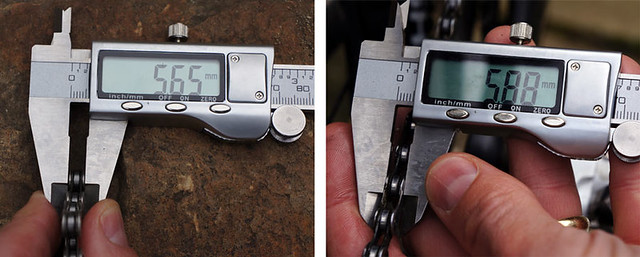
Another issue with running 10 and 11-speed on touring bikes is that not all shops around the world will have access to these somewhat modern parts. Head down to Cycling in Remote Areas for more on this topic.
Front Cranksets
Touring Cranksets
A touring crankset has a wider range of gears than a mountain or road bike crankset. The smallest chainring is often 24t and the largest 48t with a 36t servicing the middle gears. Touring cranksets require a long-cage MTB derailleur to cover the large differences in chainring sizes.
One, Two or Three Chainrings
Touring bikes commonly use three chainrings on the front crankset, although new crankset/cassette technology permits a wide spread of gears using both single and double chainring setups. Most MTB double cranksets will give you enough ratios to get up any hill with panniers. With a single chainring drivetrain, you’ll have to sacrifice some high or low gears compared to 2x or 3x. Single chainring setups tend to be best left to light touring bikes completing relatively flat tours.
Splined Cranksets
Some manufacturers (such as White Industries) mount their chainrings onto their cranks with a splined interface, rather than using bolt-on chainrings. This system allows for various chainring configurations with a maximum of a 24 teeth gap between the biggest and smallest chainrings (eg. 48x24t or 50x26t). This system allows for the same range as a triple touring crankset.
Bolt Circle Diameter (BCD)
BCD is the bolt measurement used for different types of chainrings. MTB and road chainrings are incompatible due to differences in their respective BCDs. Traditional road and compact road chainrings are also incompatible.
Here’s a list of the standard chainring BCD sizes:
104/64bcd: MTB 4-arm cranksets
110bcd: Compact and semi-compact 5-arm road cranksets
130bcd: Traditional 5-arm road cranksets
130/74bcd: Road triple 5-arm cranksets
135bcd: Campagnolo 5-arm road cranksets (including triple)
Bottom Brackets
The bearing interface that your crankset spins on what is called the bottom bracket. BBs screw directly into the threaded BB shell on a bike frame. Older-style BBs are commonly known as square taper. Square taper systems work just fine, and spare parts are available in most bike shops around the world.
Next came external BBs which still screw into the BB shell, however, the bigger bearings sit outside the BB shell. The system is stiff and reliable. Using external bottom brackets, I’ve managed to cycle up to 20,000km before needing to replace them. External BBs are standard for many modern road and mountain bike cranksets.
The latest technology for bottom brackets is press-fit, whereby the bearings are pressed rather than threaded into the bottom bracket shell of a frame. You probably won’t find this available on many touring specific bikes, but it is becoming very popular on cyclocross, road and mountain bikes.
Cassettes
Cassettes are getting wider and wider, due to the push by the cycling industry to move away from triple-chainring drivetrains. Wide cassettes are finally allowing people to tour successfully on double chainring setups.
Road and MTB Cassettes
Standard road cassettes generally max out at 27t, however, there are now road cassettes that get to 32t (you must use a long cage road derailleur with these). MTB cassettes are available from 11-32 to 11-36t (long cage MTB derailleur required for double and triple setups).
Wide-Range Cassettes
Shimano and SRAM have recently brought out cassettes with 40t and 42t cogs. These wide range cassettes are designed primarily for mountain bikes to run a single front chainring. While the SRAM cassette requires you to have a specific hub with an XD driver, the Shimano cassette will fit onto existing 11-speed hubs.
11-speed Cassettes
A wider freehub body is required on your hubs in order to fit an 11-speed cassette. Please check whether your hub is compatible before setting your bike up.
Cassette Modification for a Bigger Range
In order to turn regular 10 speed 11-36 cassettes into 11-40t, a number of companies have cropped up to make space by removing one of the smaller cogs (16t or 17t) with a bigger one (40t or 42t). This setup is proven and works well on single drivetrains. Check out Hope or OneUp for more.
Derailleurs
Not all derailleurs work with all cassettes and chainrings. The derailleur cage comes in multiple lengths, depending on what cassette you’d like to use. Any triple drivetrain must use a long cage derailleur.
Short Cage Derailleurs: Accept cassettes up to 28-30t.
Long Cage Road Derailleurs: Accept cassettes up to 32t
Long Cage MTB Derailleurs: Accept cassettes up to 40t.
SRAM 1×11 Derailleurs: Should only be used with their 10-42t cassette
Internal Geared Hubs and Gearboxes
Bikes with internally geared hubs often have a reduced gear range compared to a touring crankset and wide range cassette. The Rohloff hub is the only product that gets close with a 526% jump from the smallest gear to the largest. Comparatively, Shimano’s Nexus 8-speed has 309% range and the 11-speed 411%.
Shimano Hubs
The minimum gear ratio you can use with a Shimano hub is 1.9:1. Therefore a 26″ 8-speed bike will have gears as low as 26-79″ and a 700c bike will go as low as 27-84″. A 26″ 11-speed bike will have gears as low as 26-105″ and a 700c bike will go as low as 27-111″.
Rohloff Hubs
The minimum gear ratio you can use with a Rohloff hub is 2.5:1. Therefore on a 26″ Rohloff bike, you can get as low as 15-95″ and on a 700c bike you’ll get 19-102″.
Pinion Gearboxes
Pinion gearboxes have a huge range (636%), providing both lower and higher gears than a Rohloff hub.
Part 3: Cycling in Remote Areas
In the western world, it is becoming harder and harder to obtain high-quality spare parts for 7, 8 and 9-speed, however, in the rest of the world – you might have a hard time accessing
If you’re off on a big adventure through remote areas of the world, I recommend using a 9 or 10-speed drivetrains due to part availability. It is much more likely that you’ll find chains, cassettes, chain links and chainrings.




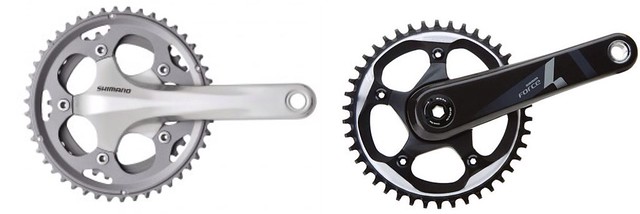


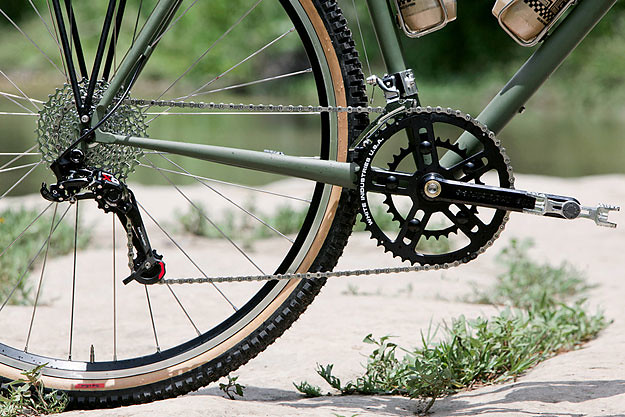



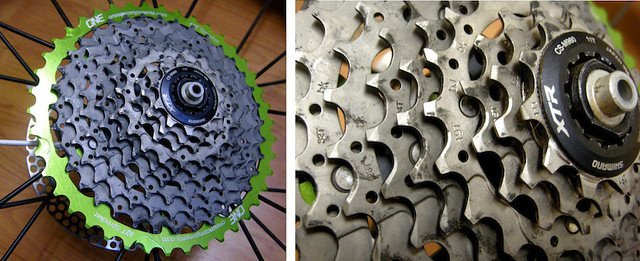
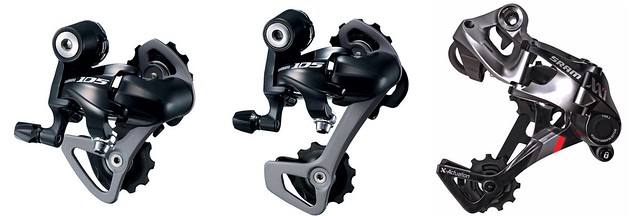

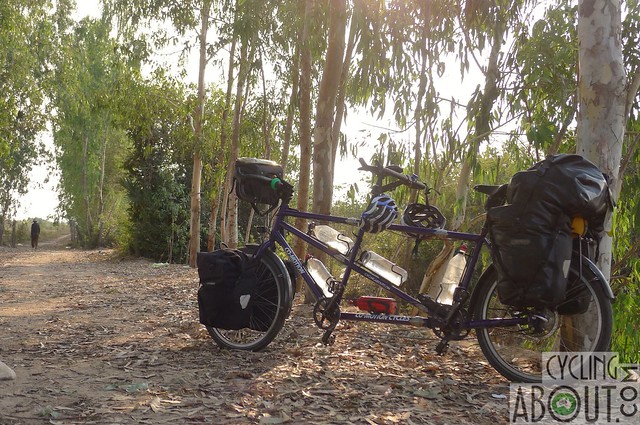
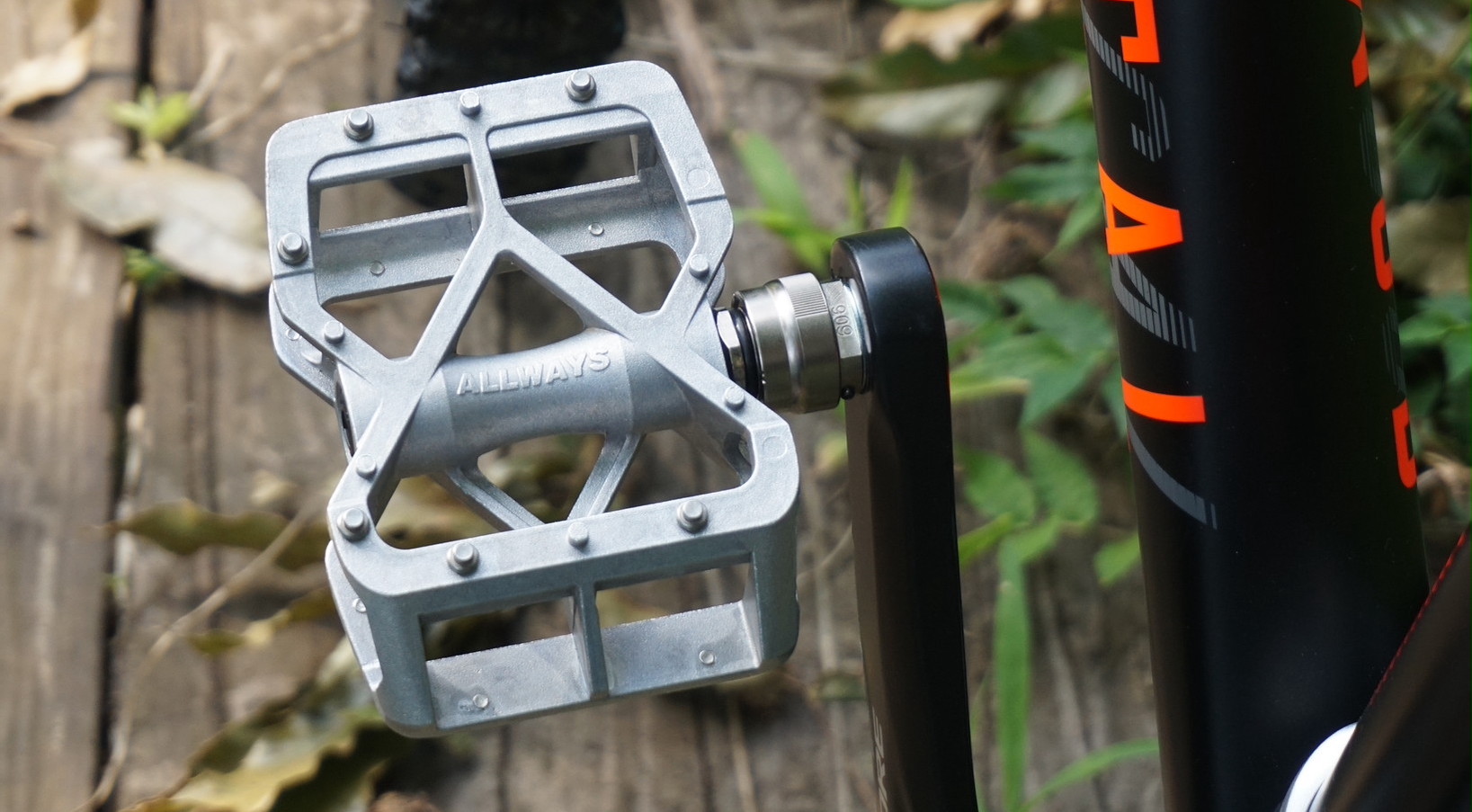
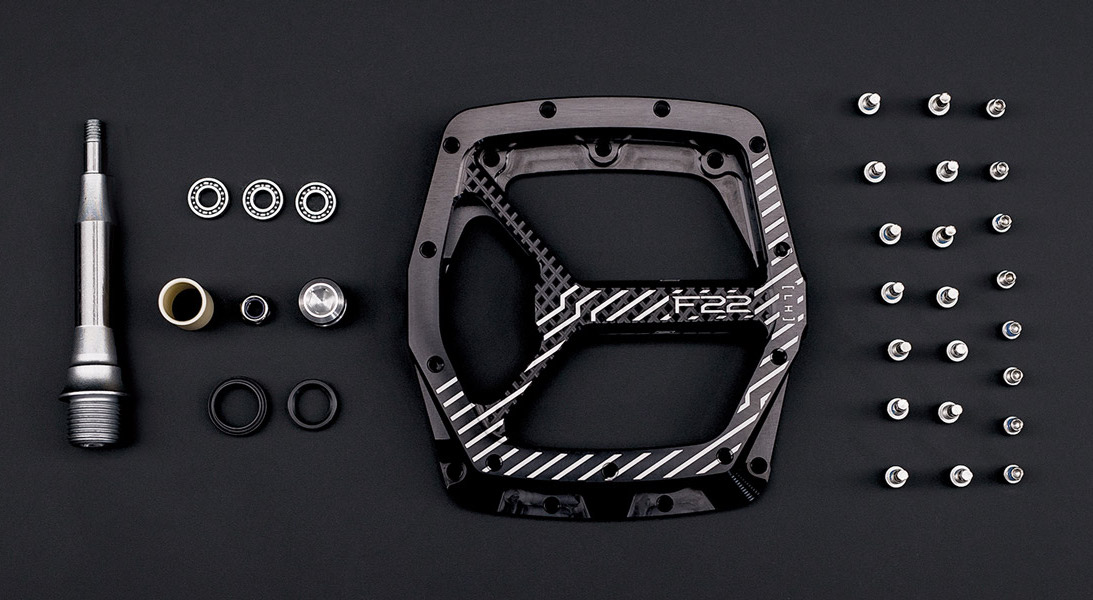


Thank you for this highly informative article! It was very helpful for me.
Glad we can help you out, Paul!
Do I need a different/special front derailleur with the White Industries crank running a 48/24? Big, but very useful gap indeed!
By the looks of things (an image search), a regular front derailleur seems to be able to handle the big gap. If you find out something different from White Industries, let us know!
Cheers. Will report back!
Thank for the article, it really helped settling some issues for the next travel bike!
Thousands thanks for your nice articles
No problem, Saied!
The new travel bike is one step closer, but I’m still stumbling across the 24 teeth gap, as I’m going with hydraulic disc brakes.
Will it work with indexed shifter (like SRAM s700)?
All the examples I have found so far are using non-indexed shifter (down tube or bar end shifter…).
I don’t see why not. Send White Industries an email enquiry and report back!
…just wrote them an email.
Will report back here once I hear from them!
Doug from White Ind. replied and here is what he said:
“Hi Joakim,
I have a bike friday with a vbc and a 52-32 chainring combination. The shifting is great but I’m using Shimano 105, but we haven’t been able to make Sram front changers work very well with our vbc rings. That said… I’ve not tried
any of the road stuff only the older mt bike changers.”
So, I’m I right in thinking that the Shimano hydraulic STI’s would possible be a better pick?
By the sound of it, Shimano STIs are the safest option. I’m surprised they couldn’t give you an answer on SRAM!
With the re-intro of the 50.4 BCD crank setup the compact double adds a new dimension to the mix. I’d prefer this to the Shimano IGH setup as (imo) the internal drag on shimanos alfine 11 negates it’s use over a long haul.
Thanks for this great article! Very helpful. On my current commuting/touring rig I’m wanting to go from a 3x to a 2x chainring. White Industries might be my best bet.
I’m quite interested why you’re wanting to go from 3x to 2x. I’ve found more people trying to go the other way so that they can have a greater range, and less gaps between each of the gears on the cassette.
Thanks for this and all your posts! They’ve been extremely helpful while I plan my new build. Such a great resource.
It’s a pleasure, Rob. Drop us a picture of your build when it’s complete!
I want to run a 60T (BCD 130) chainring. Which front derailleur can handle that? And if I could use a 10-30+ cassette, I would finally be in heaven…
In other words, which derailleurs have the highest capacity?
Hi,
I am wondering using my triple crank with an alfine 11 and what I should do to make it work. Any useful idea to do it….
Thanks
Hi Luigi. The Alfine isn’t really designed to be set up with more than one front cog. The minimum ratio you can run is 1.9:1. So if you wanted climbing gears that’s 32/16, 34/18, 36/19, 38/20 or 42/22. A road triple crankset will use a 130bcd 39t middle ring which would work with a 20t rear cog. A touring triple would use a 104bcd 36t middle ring which would work with the 19t rear. Alee
Hi Mike. You should be able to run an ordinary road front derailleur with a 60t chainring. The highest capacity rear derailleurs (MTB long cage) offer around 45t capacity, so coupled with an 11-34t cassette you should technically be able to run a 39t front ring too. (60-39=21 and 34-11=23). Alee
A lot of people still use 5 arm stuff on their MTBs, I do. Middleburn have the details on their site. http://www.middleburn.co.uk/products/chainrings/mountain-bike-chainrings/atb-chainrings
MTB compact 94/58
MTB standard 110/74
Great article, but how are you calculating these numbers: Traditional Road – 53x39t with 11-23t = 44 to 126″? I’m upgrading from a triple 9-speed to a double 10-speed. I want something great for climbing and speed. I’m considering a 10-speed 53/39t with 11/28t. Any input would be greatly appreciated.
Or I’m considering 53/39t with 12/30t…
Last time…or I’m even considering 53/39t with 11/32t.
I use this calculator. You’ll need to input your ratios, wheel size and tyre width. http://sheldonbrown.com/gear-calc.html
53/39 and 11-28 = 36-126″
53/39 and 11-30 = 34-126″
53/39 and 11-32 = 32-126″
What might my options be on a Shimano Tiagra 10 speed 11-28 cassette and an FSA 50/34. That give me 32-120 gear inches. With that unloaded I can climb an average of a 12% gradient (maxed out at 20%), albeit at a low cadence. So it might be ok for touring flatlands, but will struggle with 10kg of gear on more hilly parts.
Check out this resource, Mike: https://www.cyclingabout.com/wider-gear-range-road-shifters-gears-for-easier-hill-climbing/
My favourite hack is using a 9-speed MTB derailleur with a 10-speed MTB cassette. You’ll be able to run up to 36t on the rear!
Perfect thanks. Just need to figure out which 11-36t cassette and 9-speed derailleur to buy now. M771 XT, Dyna-sys SLX etc.. Any recommendations for an economic setup? Thanks in advance.
The SLX level stuff is definitely the best bang for your buck…
Hi Alee,
CA has become one of my absolute favourits. Thanks! Interested in what you say about combining 9/10 speed sti:s and a 9-speed rear der from a mtb group. Does it matter if it’s shadow or not? What I’ve managed to find available are either a Deore RD-M591-SGS – non shadow (which accepts only up to 34 rear sprockets) or a Deore XT RD-M772-SGS – Shadow (which seems to accept 36 rear sprockets). Of course the possibility to use 36 is better than 34, but will I have issues with a shadow rd and sti:s? Some forum I saw suggested that might be so. Grateful for your advice,
/Henrik
I’m glad you like CyclingAbout! Any 9-speed will do the trick, as they all use the same cable pull ratio.
What gearing did you run on your tandem? I’m getting ready to do a ride across the US next summer. (northern’ish route) We are riding a Co-Motion Periscope w/ 700c wheels and am looking for recommendations. I still have the stock 52/39/30 and 11/32 on it but I know I need a lower low end.
The lowest gear on my tandem is 18 gear inches! You currently have 26 gear inches with your setup. Here’s some ways you might be able to reduce your low end: https://www.cyclingabout.com/wider-gear-range-road-shifters-gears-for-easier-hill-climbing/
Hey, just found your site and am loving it. Very helpful and informative. I have a question about this article–your recommended high gear inches are usually in the 100-110 range. I bottom out at about 27 MPH on my current highest gear inch (700c x 28 road bike), which is only ~85.” I can’t really imagine needing to pedal faster than that. Of course, coasting down a hill at 35 mph is great, but when loaded I’ll get going even faster. This is for a pacific coast tour, so not incredibly hilly, but lots of small hills, and I like having more room for microadjustments (44x39x24 in front, 14-28 in back). I was just wondering what your thoughts were on having a lower-than-suggested highest gear inch. I haven’t toured with this setup yet, and I haven’t toured at all in 7 years, so my memory might be foggy, but I can’t imagine needing to pedal at a sustained 25 MPH + rate
The amount of time that you’ll find yourself travelling at over 27mp/h (43km/h) is very minimal, so in the scheme of things, having a big gear is not particularly important. There are a few instances where I like having them though: with a roaring tail wind, to keep my momentum over rolling hills and so that I can pedal while descending.
You article was really useful and clear enough for a relative newbie to understand. Great job. I hope you can answer a couple of questions for me… I’ve got a 7 speed Bike Friday, with 130 bcd single crank. The BB is 111.5mm, 68mm English (I don’t really know what that all means). I’d like to install a double chain ring, probably 50/39. I also would not mind new cranks at 165mm instead of the 170 I currently have (I’m 5’4″). Can you advise exactly what I need to be looking for in terms of specs? Can I use a 110 bcd compact double? Will any crank set work with my existing 7 speed gears? Do I need a particular type to work with my bottom bracket? I’ve done basic mech work on the bike but this would be my biggest upgrade and I don’t want to order the wrong things. The other thing I’m wondering about is whether I can just add a second chainring to my current single. Currently it is a bashguard+52t chainring. Can i remove the bashguard, put the large chainring in that place, and put a smaller chainring where the original one was? This would be the cheapie solution with greasy finger shifting.
The chances are that you already have a 130bcd crankset. That means you could find 6, 7 or 8 speed chainrings to install to make it a 53/39 double – you should be able to use your existing bottom bracket too. I don’t see why you couldn’t install a square taper compact crankset if you wanted lower gears again.
Maybe give Bike Friday an email to track down the best front derailleur for your bike.
I have Aurora Elite 2013, which i have used to tour NZ four times and Europe twice, 10,000km, great bike.The gearing is a real issue that holds this cycle back.
Upgrades to the 2016 are great but I feel that more improvements can be made to this great touring cycle even better.
Modifications done to improve my 2013 model. NZ has some serious climbing, Lewis Pass South Island, Gentle Annie North Island, Hastings to Lake Tapuo.
The GEAR RANGE i believe is an issue, climbing ability of the bike needs to be improved for carrying loads, comment appears in a number of cycle touring forums and sites. The AURORA ELITE is a serious competitor to SURLY LHT except for gearing.
My Modifications
Rear cassette: 12-36.
I felt no need for the 12 and I modified again to 14-36.
Ultegra junior 14-25, 10 speed removed three cogs and inserted 28/32/36 MTB 10 speed. Using a Ultegra Junior allows for better selection of the three cogs to remove my choice was 15, 17, 20. Essential cogs are 14 locking and 21,23,25 grouped.
Result: 14,16,18,19,21,23,25,28,32,36.
14 locking, Choice Area of 3 cogs from (15,16,17,18,19,20) 21,23,25 grouped, 28,32,36 grouped
You can achieve close selection of gears through Your critical touring range, then three for climbing, occasionally I use the 14/50. No issues with gear selection, issue with cross gearing is reduced.
Rear derailleur: long cage XT. Shimano XT M771 9 Speed Rear Mech.
Crank set: 105 triple bcd 130/74. 50/39/28. Adding standard 105 triple bcd 130/74 crankset allows the easy modification from 50/39/30 to 50/39/28 or 48/38/26. The bike has flexibility to easy modify. Replace FC-R563 with 105 triple 130/74, FC-5703. I included 175 crank arm length.
Do the calculations on Sheldon Brown site, the result is good.
Shifters: 105 STI. Found these easier to use especially in urban areas. Had no issues with breakdown with STI. STI Shifters are well designed now.
Bar ends are good if going extreme remote.
Hub Rear: XT rear. Had bearing issue with standard hub. Most touring bikes opt for the XT. XT move suited to load carrying
Hub front: Upgrade Dyno
These ideas have been passed to Jamis.
Hi Jo. That’s a very well thought out drivetrain! I’ve often thought about how I’d custom design a cassette for touring, but I’ve never actually done it. Thanks for sharing. Alee
I am thinking of changing the cassette on my 26 inch rear wheel from 9 speed to 10 speed so I can get a 40 granny gear, currently 32. I assume I will need to buy a new gear change lever for the front handlebars. Do I need to change my existing Deore XT derailleir as well. What about the chain. And what about my triple chainset at the front.
I don’t know why more folks (author included) don’t know about this… don’t know why it is an industry secret; but it is not 100% true that you have to have a new “11-speed” hub to use an 11-speed cassette.
The Shimano XT CS-M8000 wide-range cassettes of 11-40T, 11-42T, or 11-46T all fit fine on older 8/9/10-speed hubs.
This is because the largest cog is so large, when you’re on it, the rear derailleur cage won’t hit the spokes — so Shimano didn’t need to space out the inner cog from the hub as much as with smaller road ratios (such as 11-25). So using one of these XT cassettes is a great way to gain gear ratios on existing (or now cheep used) wheels.
Note, you can get a 130BCD 38T ring from both FSA and SRAM; so you can match the 38/20 exactly.
hi … i just found your webside and it is very helpfull to me … ) i am just on the way to built bike for myself … i alredy orderd frame INTEC M1 …
I have read meny articles about touring bikes … but my level of englis is not so good to understand technical stuff … and I would like to understand my bike but I dont want to spend to much time on the internet just reading something that i dont understand properly …
So i would like to ask you for your help … help to create set for my bike … I already chose almost all components but I have problem to chose right geer set ( front-rear derailleur , cassete , crankset, chain … )
can you plese make some simple set for mee … I would like to use this bike for almost everything … offroad, road long touring … so uphill and also flat areas … with all my gear ( heavy load ) …
and I trying to do this as cheap as possible … I would like to go for shimano …
can you help me please ? 🙂 sorry if this sounds silly … but it could be huge help to me …I alredy spend too much time on the internet just searching about this … and i would like to decide somehow … but I think if you alredy know a lot about this ,,, it will be much better decision …
thanks and have a nice day ) ,,
D.
Try this good value, wide range drivetrain:
Crankset – Shimano M590 26/36/48t
Bottom Bracket – Shimano MT800
Front Derailleur – Shimano Deore FD-M611-D
Rear Derailleur – Shimano Deore RD-T610 SGS 10 speed
Cassette – Shimano HG-50 11-36t 10 speed
Chain – Shimano XT 10 speed
Shifters – Shimano Deore M591 10 speed
Thank you:)
Can you maybe set something for 3×9 -I would like to use nonindex ( friction) shifters…. what you think about this??
Thanks again for answering)
Switch out the Deore shifters for Microshift SL-M10. 🙂
Thanks man)
I really appreciate your help) …
Enjoy your day…
D.
Truth here is you don’t need road chainrings in front with 28-29 inch wheels at all if you like fully loaded style. For light bikepacking it’s ok
Hi again… I would probably like to change it to 9 speed cassette and square bottom bracket cause I would like to go mostly to part of the world where is no possibilities to buy modern spare parts… can you maybe help me with this:) ?
im also considering an INTEC M1 frame, please update me on your build and your experience with the frame.
hi i just finished my build … so frame is really nice .it is also really light, similar to aluminium frames ,,maybe even lighter …. .. good geometry so far ,,, at the beginning it was little bit weird for me cause before I had 29 wheels … but it is ok now … it is actually nicer for me cause it is much more sensitive in corners for example … and I like that … I would like to use this frame also in small mountain areas … and because of this I would like to use suspension fork … but this frame is not compatible with them … so I am thinking about selling this frame … 🙂 ,,, but it is good so and it will be probably hard to sell it … so maybe I will keep this one … if you would like to know more ..or some details … just ask me … you can also write me to my e.mail : de.pollak@gmail.com
🙂
pictures … I wasnt able to upload here my pictures so if you want to see my bike … send me your e-mail …
Hi just wondering how much would you notice the difference in 33 gear inches and 31
It’s not all that huge. At 60 RPM pedalling cadence, you will be able to drop from 9.5km/h to 8.9km/h. Still, every bit can help!
Definitely. A big chainring of 44-48t is generally adequate for loaded touring.
I currently have the Shimano Ultegra 6800 groupset on my road bike, but would like to change the front crankset to the Shimano 6703 triple. Would that be compatible?
how did you ship a tandem bike to Cambodia?
Great article and suggestions for a set of components. I had a similar list based on the same M590 Crankset, but wasn’t sure if it could all work together. I think I prefer your list. Thanks for that.
Sorry, missed your comment! You should be able to use the 6703 shifter, front derailleur and crankset with the rest of the 6800 groupset (note: slightly different pull-curve at the lever, resulting in a different brake feel).
The frame breaks into three separate parts using S&S couplers. That said, I just use the front three couplers and put the entire tandem into a regular cardboard bike box.
I found out that 9 speed is the most versible option. Mountain bike derailleur works with road bike STI shifters, Sram gripshift works with Shimano derailleur, Sram cassettes work with Shimano, Shimano cassettes work with Sram. With 10 speed most of this combinations will not work, with 11 speed any of these combinations will not work. Even the latest 10 speed groupset does uses a diverent ratio then the older 10 speed groupsets. With 9 speed everything is exactly the same. Also please keep in mind Shimano just launched the new Sora R-3000 9-speed groupset the whole groupset cost you less then 300 euro or dollar. Its a bid more havy comp[ared to the expensive stuff, but the qualaty is the same and the more havy parts are stronger. 9-speed will be aruond for a very long time. On the moatainbike front deore or xt parts in 9 speed will also be available for a long time. 10 or 11 speed only make sence if you do’nt have a triple, exept fot the 3×11 Campanolo Athena on my road bike or on mountainbikes or cross bikes, on a touring bike not using a triple is not a smart thing to do, you simply do not have enough gears without it, there is also a new 12 speed sram system, this gives you more but still only 500% diverence where a triple gives you about 550%, you need at least 520%. This means you need Rohloff or a triple, if you choose a triple you do not need 10, 11 or 12 speed. And 9 speed keeps you happy with everything you want put on your bike and everywhere you want to go.
Getting set up for better touring bikes for my wife and I.
I post this in this discussion line because it’s mostly a touring GEARING question (I’ll get to that!)
Let’s pay attention to these givens: i.e. responses should please address mostly gearing/groupset rather than debate other things and go off on long tangents.
Bikepacking…….Bike Touring…….call it what you want (that’s a whole different topic).
For the majority of our touring riding…….not thinking a ton of technical single track, but might run into some occasionally. Mostly gravel, two-tracks, pavement, cobble, etc. But yet……single track capable (more-so without the load). Thinking racks with smaller panniers (Ortlieb gravel’s- front & rear)…….not thinking bikepacks. Racks with some capability for also putting stuff on top. (so not really low-riding in front). Willing to add a few pounds to the gear for comfort/convenience……so NOT ultra type set-up. In my mind the ultra is a different rig altogether…….so I’d set up a different bike/rig to go lighter-weight singletrack shredding with the guys (perhaps a 1x). Thinking anywhere from a week (only 1 set panniers or perhaps just a dry bag on the top of rack)……..to perhaps month+ longer tours (both panniers and other places on bike). Thinking unsupported……yes camping with the lightweight gear…..not totally credit cards.
Be sort of nice to get same bikes for both her and I…..around 54cm and I’m tall, so 60-61 cm. (I know, I know…..can make arguments against this same-bke thing). I’ve got them all now- road, cross, mtb, tri…..but no touring yet. She’s got road.
We are both in fairly good physical shape & riders. Kids are gone…..we can step back from fulltime work a bit more…..so we’ve now got some time to tour more. I’m selling the tricked-out tri so I’ve got some $$ to spend on this project. TONS of bike to select from out there. I ride Specialized, Salsa and some others and my LBS is Trek. I think today’s aluminum can handle our type of touring (and can save a few lbs over steel). As I said, I have an assortment of bikes…….so my inclination in an on-off road tourer is a 2″ tire at min. As I said…..the other set-up mentioned above is 3″+. So, I’m thinking 29’r touring. I think hardtail is OK…no suspension stuff. Also thinking the comfort/loaded-bike stability of some sort of flat-bar Vs drops. Looking at the assortment of NEW (not thinking used) touring/adventure bikes out there……the stock components are deficient in many/some areas……….SO I’M THINKING A BUILD. Also remember I’m talking racks, front dynamo (likely an SP), very good wheels (likely a Velocity Blunt SS- it’s 26.6-30 wide & do a 32 or 36 spoke), disc brakes, appropriate gearing (29’r here so Mtb not road), easy to maintain/fix (even in remoter places- but no I’ll not buy 26″), etc…….the wish list goes on.
Sorry for rambling……but many on forums ask for more “background” info.
With the LBS Trek and my mechanic there……..I’m leaning towards Trek 920…….that frame to build. Use their F & R racks (they are decent)…throw some fenders on. Keep the alum fork that comes with. Thinking Jones Loop H bar and keeping bar-mount goodies off the side a bit to keep a bit of possible front aero hand position. Like that bar’s possible multi positions for hands. Continuing……
Disc brakes……..go hydraulic or mechanical disc? Web forums tilt me somewhat toward mechanical…..but modern technologies and my LBS guy tilt to hydraulic. Opinions? Also, which brand & model?
THE MEAT HERE……..WHAT TO DO FOR CRANK, SHIFTERS, CASSETT?
(please skip the discussion of Rohloff & Pinion)
Crank- I’m thinking a double (sorry for those triple arguments out there)…..and remember the single track bike mentioned above could be my 1x). With today’s components…..we should be able to do what we want with a dbl.
Shifters- mtb type stuff…..trigger… no thanks on anything bar-end.
Derailleur…….got to be long to handle the gears……and the 920 has the chainstay.
Cassett- thinking 10 speed. Not opposed to others. And would consider 40T plus options.
Gearing- Low- how low do you go? Is 19-20 gear inches low enough? CHECKING SPEC’S OF MANY OF THE NEW “TOURING” STUFF OUT THERE………VERY FEW HAVE ENOUGH LOW END IN THE STD COMPONENTS. I know…..you’re going to ask me what’s the biggest hill you expect? What’s your total weight? etc. etc… Who knows?………picture the worst (and I’m not against walking up something!). I’m just say’n…….what would you do?
Gearing- High- remember, could be riding this unloaded (not on tour, or after setting up camp). Need something at the top to have fun! So over 100 inches or over at least?
Think “mid-level” priced components……but would spend more for just the right set-up. Sort of leaning towards SRAM. And remember in all of this………if something brakes……I need to be able to have it fixed fairly easy in the developed world. Either exact replacement…..or something that will get me by.
OK……….WHAT WOULD YOU DO IN THIS BUILD SITUATION?
THANKS FOR YOUR INPUT.
STEVE,,,,,,,
Hey Alee… while ya got that fancy measuring tool out, how about giving us the specs for the widths of 7,8, & 9 speed chains? How much difference do we see between them? I’m wondering specifically if I can use a 10-speed front derailleur with a 9-speed set up? Same with 10 speed front cranks? Are they so much more narrow that a 9 speed chain won’t work on them properly? Thanks in advance and keep up the great work.
They can be interchanged in many cases (you’ve got to have a bit of luck on your side with the combo). It’s not usually a function of the chain width, but rather the cable-pull ratio from 9-speed shifter to 10-speed front derailleur that counts.
Well that’s good news, because I’m using bar end shifters and the front is friction. I was concerned that the width of the cage might be more narrow and I’d have trouble with adjusting the trim, but heck… this sounds good! Thanks for the speedy reply. Cheers!
Thanks for this! Recently purchased a used cyclocross bike with a 46/38 up front and 11-26 10 speed in the rear. It’s great for 90% of what I do, but when going up a hill, on gravel I don’t quite have the low end that I’d like. This is especially true when lugging around my 2 year old in the trailer and now I have ~60 pounds of weight I’m towing. My rear der. can only accommodate up to a 28 tooth cog, so not too terribly different than what I have now. Would going to a 36t chain ring be a better, and cheaper, option for me?
Just realized that my 130 bcd crank won’t fit anything smaller than a 38t chainring. There goes that idea! Looks like a cassette swap is my only option unless I want to buy a new crank.
Yeah, the 130 BCD stuff isn’t ideal for any hills. I’d suggest a new crankset, ideally something from this list: https://www.cyclingabout.com/low-climbing-gears-road-bike-crankset/
Or a RoadLink to fit a new 11-34t cassette and chain. https://www.wolftoothcomponents.com/products/roadlink